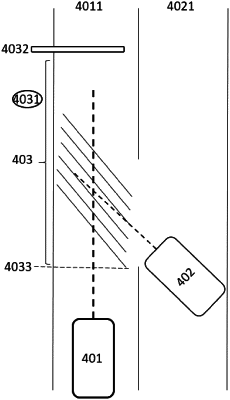| CPC B60W 30/0956 (2013.01) [B60W 30/16 (2013.01); B60W 50/14 (2013.01); B60W 2552/10 (2020.02); B60W 2554/4041 (2020.02); B60W 2554/4042 (2020.02); B60W 2554/4045 (2020.02); B60W 2554/802 (2020.02); B60W 2710/18 (2013.01); B60W 2720/10 (2013.01)] | 18 Claims |

|
1. A cruise control method, applied to a first vehicle, wherein the method comprises:
by one or more processors, calculating a braking time of the first vehicle to stop outside a preset recognition region when the first vehicle is located in a first lane and a second vehicle exists in a second lane adjacent to the first lane, wherein the preset recognition region is a region in which a vehicle recognition device of an electronic toll collection system recognizes vehicles, and the braking time refers to time required for the first vehicle to brake at a current traveling speed and stop outside the preset recognition region;
by one or more processors, acquiring a first movement parameter of the second vehicle, the first movement parameter comprising at least one of a first speed parameter, a first distance parameter and a first angle parameter;
by one or more processors, calculating a cut-in probability of the second vehicle to cut into the first lane according to the first movement parameter; and
by one or more processors, controlling the first vehicle to stop when the cut-in probability is greater than or equal to a preset cut-in probability and the braking time is less than a preset braking time.
|